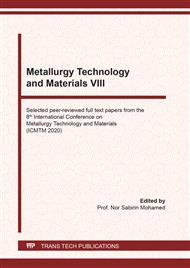[1]
E. Takahashi, T. Sakurai, S. Watanabe, N. Masahashi, S. Hanada. Effect of heat treatment and Sn content on superelasticity in biocompatible TiNbSn alloys, Mater. Trans., 43(2002) 2978-2983.
DOI: 10.2320/matertrans.43.2978
Google Scholar
[2]
T. Maeshima, M. Nishida, Shape memory properties of Biomedical Ti-Mo-Ag and Ti-Mo-Sn alloys, Mater. Trans., 45(2004)1096–1100.
DOI: 10.2320/matertrans.45.1096
Google Scholar
[3]
Xingfeng Zhao, Mitsuo Niinomi, Masaaki Nakai, Junko Hieda. Beta type Ti-Mo alloys with changeable Young,s modulus for spinal fixation applications. Acta Biomaterialia, 8 (2012) 1990-1997.
DOI: 10.1016/j.actbio.2012.02.004
Google Scholar
[4]
J.L. Xu, S.C. Tao, L.Z. Bao, J.M. Luo, Y.F. Zheng. Effect of Mo contents on the microstructure, properties and cytocompatibility of the microwave sintered porous Ti-Mo alloys, Materials Science & Engineering C, 97 (2019) 156-165.
DOI: 10.1016/j.msec.2018.12.028
Google Scholar
[5]
Y.L. Zhou, D. M. Luo. Corrosion behavior of cold-rolled and heat treated Ti-Mo alloys. J. Alloys Compd., 509 (2011) 6267-6272.
DOI: 10.1016/j.jallcom.2011.03.045
Google Scholar
[6]
R. P. Kolli, W. J. Joost and S. Ankem. Phase stability and stress-induced transformations in Beta Titanium alloys. The minerals, Metals & Materials Society, 67 (2015) 1273-1278.
DOI: 10.1007/s11837-015-1411-y
Google Scholar
[7]
Xueyin Zhou, Xiaohua Min. Effect of grain boundary angle on {332}<113> twinning transfer behavior in β-type Ti–15Mo–5Zr alloy. Journal of Material Science, 53 (2018) 8604-8618.
DOI: 10.1007/s10853-018-2167-x
Google Scholar
[8]
Xueyin Zhou, Xiaohua Min, Satoshi Emura, Koichi Tsuchiya. Accommodative {332}<113> primary and secondary twinning in a slightly deformed β-type Ti-Mo titanium alloy. Materials Science and Engineering A, 584 (2017) 456-465.
DOI: 10.1016/j.msea.2016.12.025
Google Scholar
[9]
N. T. C. Oliveira, G. Aleixo, R. Caram, A.C. Guastaldi. Development of Ti-Mo alloys for biomedical applications using AC: Microstructure and electrochemical properties. Mat. Sci. Eng. A, 452-453 (2007) 727-731.
DOI: 10.1016/j.msea.2006.11.061
Google Scholar
[10]
L. Usategui, M.L. Nó, S. Mayer, H. Clemens, J. San Juan. Internal friction and atomic relaxation processes in an intermetallic Mo-rich Ti-44Al-7Mo (γ+β0) model alloy Sci. Eng. A, 521-522 (2017) 495-502.
DOI: 10.1016/j.msea.2017.06.014
Google Scholar
[11]
J.R.S. Martins JR, R.O. Araújo, R.A. Nogueira, C.R. Grandini. Internal friction and microstructure of Ti and Mo alloys containing oxygen. Arch. Metall. Mater., 61 (2016) 25-30.
DOI: 10.1515/amm-2016-0011
Google Scholar
[12]
Z. C. Zhou, Y. F. Yang, S. Y. Gu, X. B. Zhu, et al. The Atomic Defect Relaxation Processes in the TiMo Alloys, Mater. Trans., 61 (2020) 1051-1057.
Google Scholar
[13]
J. L. Murray, Phase Diagram of Binary Titanium Alloys, Materials Park, ASM, Ohio (1987).
Google Scholar
[14]
X. H. Min, S. Emura, L. Zhang, K. Tsuzaki, Effect of Fe and Zr addition on ω phase formation in β-type Ti-Mo alloys, 497 (2008) 74-78.
DOI: 10.1016/j.msea.2008.06.018
Google Scholar
[15]
O. Florêncio, F. W. J. Botta, C. R. Grandini, et al. Anelastic behaviour in Nb-Ti alloys containing interstitial elements. J. Alloys Comp., 211-212 (1994) 37-40.
DOI: 10.1016/0925-8388(94)90442-1
Google Scholar
[16]
A. S. Nowick and B. S. Berry, Anelastic Relaxation in Crystalline Solids, Academic Press, Now York and London (1972).
Google Scholar


